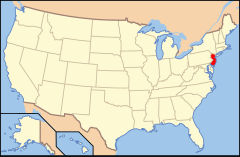
Paleontology in New Jersey refers to paleontological research in the U.S. state of New Jersey. The state is especially rich in marine deposits.
During the Precambrian, New Jersey was covered by a shallow sea that was home to stromatolite forming bacteria. During the early part of the Paleozoic, the state was still covered by the sea, which was home to creatures like brachiopods and trilobites. By the Silurian, the northern part of the state was home to a river system. Sea levels rose and fell throughout the remainder of the state's Paleozoic rock record. There are no local rocks of Carboniferous or Permian age. During the Triassic, the state was a terrestrial ecoregion. Local lakes were home to the crustacean Cyzicus and the coelacanth Diplurus. On land, dinosaurs left behind footprints, and continued to do so into the Jurassic.
A sea rose over southern New Jersey during the Cretaceous. Invertebrates, plesiosaurs and turtles lived in its waters. Dinosaurs roamed the land. New Jersey has the most fossiliferous Late Cretaceous rocks of the Mid-Atlantic region.[1] Southern New Jersey remained a sea home to invertebrates and sharks into the Cenozoic era. By the Ice Age, northern New Jersey was home to mastodons and glaciers covered the northern part of the state. Local Native Americans are known to have possessed petrified wood. By the late 18th century, local fossils had attracted scientific attention. In the mid-19th century Hadrosaurus foulkii was discovered and named. The Cretaceous duck-billed dinosaur Hadrosaurus foulkii is the New Jersey state fossil.